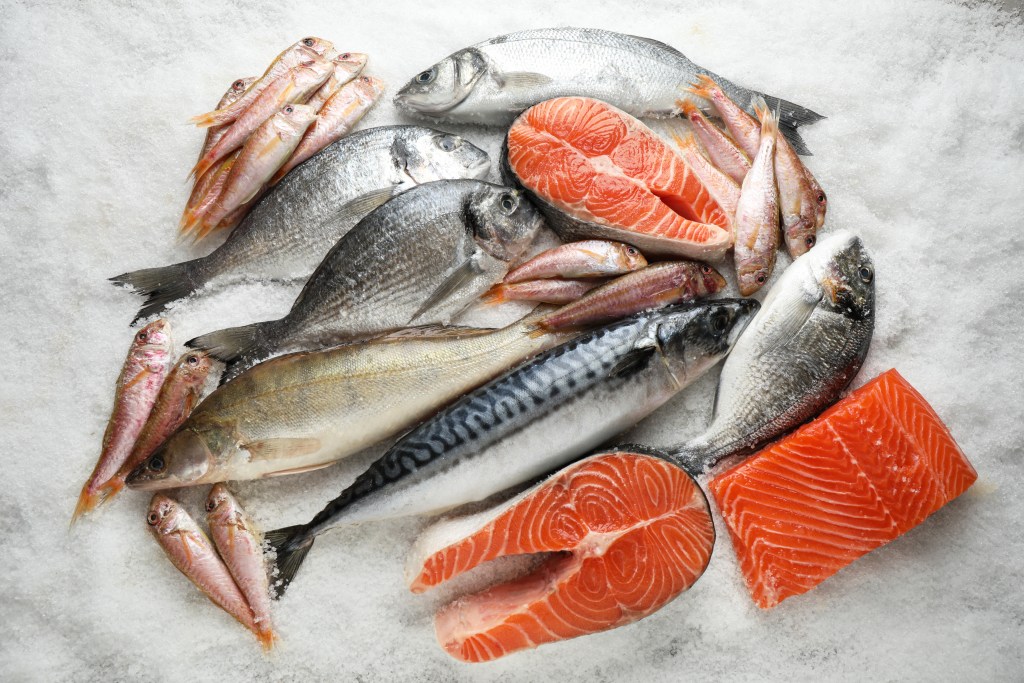At a glance
Mercury is a highly toxic heavy metal that accumulates in the body over time, which is why many people look for fish without mercury. While no fish are completely mercury-free, some species contain far lower levels than others and are safer for regular consumption. Beyond mercury content, factors such as sourcing and freshness also influence overall quality.
There are no fish without mercury, as all marine life contains trace amounts of this toxic heavy metal due to environmental pollution.
However, some species contain much lower levels than others, making them safer for regular consumption without the risk of mercury toxicity and associated health issues.
Here’s a comprehensive guide to mercury levels in fish and how to choose the safest options to minimize mercury exposure.
What is mercury?
Mercury is a heavy metal that’s naturally present in the environment and the only type of metal that’s liquid at room temperature. It has a silvery appearance and is commonly used in thermometers, barometers, and fluorescent light bulbs.
Processes such as volcanic activity and the weathering of rocks, as well as coal burning, mining, and improper disposal of mercury-containing products, can release elemental mercury into the atmosphere.
Airborne mercury particles typically enter bodies of water through precipitation, where microbes convert them into methylmercury, a highly toxic compound that can contaminate aquatic organisms.
Mercury easily accumulates in fish, particularly larger predatory species, as they ingest smaller contaminated organisms, leading to higher concentrations of methylmercury in their tissues.
Watch the video below to learn which types of fish contain the highest levels of mercury.
Why is mercury bad for you?
Mercury is highly toxic and can have serious health consequences. Mercury poisoning, also known as mercury toxicity, occurs when excessive amounts of mercury accumulate in the body, which can cause significant tissue and organ damage over time.
Excessive intake of contaminated fish is the most common source of methylmercury exposure for humans.
Methylmercury is a particularly dangerous form of mercury as it can easily enter the bloodstream and cross the blood-brain barrier, impacting the central nervous system.
Because mercury is highly reactive, it can bind to proteins and enzymes, disrupting their function and causing oxidative stress that damages cellular components such as lipids, proteins, and DNA.
Furthermore, mercury isn’t easily broken down or eliminated from cells, and mercury builds up in tissues over time, particularly in organs such as the kidneys, liver, and brain.
Pregnant women and young children are particularly vulnerable to the effects of mercury. Mercury exposure during pregnancy can interfere with fetal brain development, increasing the risk of developmental delays, learning disabilities, and behavioral problems.
Research published in Toxics summarizes the detrimental effects of mercury as follows, “Developmental exposure to methylmercury has been linked to cognitive and behavioral dysfunction in children, while cumulative exposure over an adult’s lifetime has been linked to the development of neurodegenerative diseases, such as Parkinson’s disease.”1
This highlights why pregnant women and young children shouldn’t eat fish in excess, particularly large predatory species, to minimize the health risk of consuming too much mercury.

Are there fish without mercury?
Due to environmental pollution, mercury is present in almost all marine life.
However, tiny fish and those lower in the food chain tend to accumulate less mercury as they feed on plankton and algae, which generally contain only small amounts of this neurotoxic metal.
Examples of low-mercury fish include sardines, anchovies, and herring, which are smaller fish with a shorter lifespan, greatly reducing their mercury exposure.
In contrast, larger predatory fish, such as swordfish and tuna, accumulate higher levels of mercury. As they consume other fish, the mercury content of their prey builds up in their bodies, which is a process known as biomagnification.
Here’s a guide to fish and seafood with high, moderate, and low mercury levels.
Fish with high mercury levels
It’s generally advised to avoid fish with high mercury levels or to limit consumption to no more than once a month.
Fish with high mercury levels include:
- Bluefish
- Grouper
- King mackerel
- Orange roughy
- Shark
- Swordfish
- Big eye tuna
- Albacore tuna
- Yellowfin tuna
- Ahi tuna
- Halibut
- Perch
- Sea Bass

Fish and seafood with moderate mercury levels
Intake of fish species with moderate mercury levels should be limited to once weekly.
This helps minimize the risk of mercury accumulation while benefiting from the nutritional value of fish, such as heart-healthy omega-3 fatty acids, high-quality protein, and essential vitamins.
Fish and crustaceans with moderate mercury levels include:
- Bass
- Cod
- Snapper
- Monkfish
- Canned tuna
- Skipjack tuna
- Lobster
Fish and seafood with low mercury levels
Low-mercury fish and seafood options can be enjoyed regularly and are an excellent addition to a nutritious diet, offering omega-3 fats, iodine, vitamin B12, and selenium.
These nutrients play a critical role in supporting heart health, brain function, strong immune defenses, and balanced thyroid hormone levels, making them essential for overall well-being.
Seafood and fish with the lowest mercury concentrations include:
- Anchovies
- Flounder
- Salmon
- Haddock
- Herring
- Sardines
- Trout
- Tilapia
- Catfish
- Clams
- Crab
- Crawfish
- Oysters
- Squid
- Scallops

More tips for choosing healthy fish
In addition to reducing mercury exposure by selecting fish with lower levels of this harmful heavy metal, there are several other factors to consider when choosing healthy fish.
One key consideration is whether the fish is wild-caught or farm-raised.
Wild-caught fish generally have better nutritional value, including more omega-3 fatty acids, and are less likely to contain harmful chemicals such as pesticides, antibiotics, and artificial dyes typically used in fish farm operations.
While generally more affordable, farmed fish often contain higher levels of toxins, which can diminish the health benefits of eating fish regularly.
A study published in Chemosphere found that a significant proportion of farmed fish products contains polychlorinated biphenyls (PCBs), a persistent organic pollutant linked to various detrimental health effects.2
PCBs are typically introduced through commercial fish feed, and prolonged exposure to high levels of PCBs in humans has been linked to health issues, including immune system disruption, hormone imbalances, and an increased risk of certain cancers.
“A significant percentage of the fish sold in the U.S. is farmed, leaving consumers exposed to harmful compounds and toxins,” explains Dr. Berg. “Choosing wild-caught fish is crucial to minimizing exposure to contaminants while ensuring a richer nutrient profile.”
In addition, it’s also important to look for freshness. Fresh fish should have clear, bright eyes, shiny scales, and a firm texture. If buying whole fish, check that the gills are bright red or pink, not dull or slimy.
Key takeaways
- There are no fish without mercury, but smaller species tend to contain significantly lower levels than larger predatory fish, making them safer choices for regular consumption.
- Low-mercury options such as anchovies, flounder, salmon, haddock, herring, and sardines also provide essential nutrients, including omega-3 fatty acids, protein, and selenium.
- Large predatory species, such as swordfish, sharks, king mackerel, and several types of tuna, accumulate more mercury and should be limited or avoided.
- Choosing wild-caught fish over farm-raised options can help minimize exposure to additional contaminants, such as PCBs, pesticides, and antibiotics, while offering a better overall nutritional value.
FAQ
1. Are there fish without mercury?
No, all marine life contains trace amounts of mercury due to environmental pollution. However, smaller fish such as anchovies, sardines, and herring have much lower levels, making them safer for regular consumption.
2. What is the cleanest fish to eat?
Smaller fish species such as herring, anchovies, flounder, salmon, sardines, trout, and haddock, especially when wild-caught, are among the cleanest to eat.
Wild-caught small fish tend to have lower mercury levels, are less likely to be contaminated with toxins, and contain more heart-healthy omega-3 fatty acids than farmed fish.
3. Which fish has the highest amount of mercury?
Large predatory fish such as shark, swordfish, king mackerel, and certain types of tuna have the highest mercury levels. Their position at the top of the food chain leads to mercury accumulation in their tissues as they absorb mercury from their prey, which is a process known as biomagnification.
4. What fish can you eat every day?
Small fish such as sardines, anchovies, and herring can be eaten daily in moderation as part of a balanced diet, as they’re low in mercury and rich in essential nutrients such as omega-3 fatty acids and vitamin D.
However, it’s crucial to choose wild-caught options to minimize exposure to potentially harmful chemicals, antibiotics, and other additives commonly found in farmed fish.
5. Who should be careful about mercury in fish?
While everyone is at risk of mercury exposure from fish, pregnant women, young children, and those with underlying health issues should be particularly cautious. High mercury levels can affect fetal development, impair cognitive function in children, and worsen existing health conditions.
6. Is shrimp high in mercury?
No, shrimp is considered low in mercury and generally considered a safe seafood option for regular consumption.
Sources
- https://www.mdpi.com/2305-6304/11/8/670 ?
- https://www.sciencedirect.com/science/article/abs/pii/S0045653519311725 ?

















